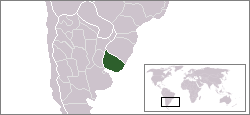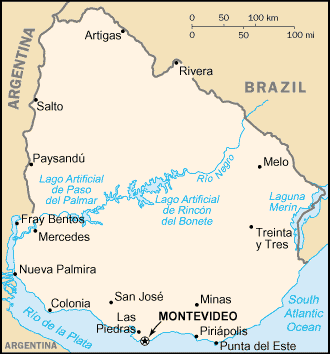This is an old revision of this page, as edited by Jpta~enwiki (talk | contribs) at 17:33, 3 April 2004 (+ fi:). The present address (URL) is a permanent link to this revision, which may differ significantly from the current revision.
Revision as of 17:33, 3 April 2004 by Jpta~enwiki (talk | contribs) (+ fi:)(diff) ← Previous revision | Latest revision (diff) | Newer revision → (diff)The Oriental Republic of Uruguay is a country in southern South America, bordered by Brazil to the north, the Uruguay River to the west, the estuary of the Rio de la Plata (River Plate) to the southwest, with Argentina on the other bank of both, and finally the South Atlantic Ocean to the southeast.
| ||||
| National motto: "Libertad o Muerte" (Spanish; Liberty or Death) | ||||
 | ||||
| Official language | Spanish | |||
| Capital | Montevideo | |||
| President | Jorge Batlle | |||
| Area - Total - % water | Ranked 88th 176,220 km² 1.5% | |||
| Population
- Density | Ranked 127th
19/km² | |||
| Independence
- Recognised | From Brazil
August 27, 1828 | |||
| Currency | Uruguayan peso | |||
| Time zone | UTC -3 | |||
| National anthem | Orientales, la Patria o la tumba | |||
| Internet TLD | .UY | |||
| Calling Code | 598 | |||
History
Main article: History of Uruguay
The first Europeans arrived in the area in the early 16th century. Both Spain and Portugal pursued the colonisation of the future Uruguay, with the Spanish eventually gaining the upper hand. The future capital Montevideo was founded in the early 18th century and became a rival to Buenos Aires across the Rio de la Plata.
The early 19th century saw independence movements spring up all over South America, including Uruguay, then known as the Banda Oriental ("east bank"), with the territory contested between the nascent states of Brazil and Argentina. Brazil annexed the area in 1821, but a new revolt started August 25th 1825, after which Uruguay became an independent country with the Treaty of Montevideo in 1828.
Uruguay then experienced a series of elected and appointed presidents and saw conflicts with neighboring states, political and economic fluctuations and modernisation, and large inflows of immigrants, mostly from Europe. The military seize control of the administration in 1973 and civilian rule did not return until 1985, a year after widespread violent protests against the military regime.
Politics
Main article: Politics of Uruguay
Uruguay's 1967 constitution institutionalises a strong presidency, subject to legislative and judicial checks. The president, who is both head of state and head of government, is elected by popular vote for a five-year term, with the vice president elected on the same ticket. Thirteen cabinet ministers, appointed by the president, head executive departments.
The Uruguayan parliament is the bicameral General Assembly or Asamblea General, which consists of a 30-member senate (Cámara de Senadores), presided over by the vice president of the republic, and a 99-member Chamber of Representatives (Cámara de Representantes). Members for both houses are elected by popular vote for a five-year term.
The highest court is the Supreme Court; below it are appellate and lower courts and justices of the peace. In addition, there are electoral and administrative ("contentious") courts, an accounts court, and a military judicial system.
Departments
Main article: Departments of Uruguay
Uruguay consists of 19 departments (departamentos, singular - departamento):

- Artigas
- Canelones
- Cerro Largo
- Colonia
- Durazno
- Flores
- Florida
- Lavalleja
- Maldonado
- Montevideo
- Paysandú
- Río Negro
- Rivera
- Rocha
- Salto
- San José
- Soriano
- Tacuarembó
- Treinta y Tres
Geography
Main article: Geography of Uruguay
Uruguay is the second-smallest country in South America and the landscape features mostly rolling plains and low hills (cuchilla) with a fertile coastal lowland; most of it grassland, ideal for cattle and sheep raising. The highest point in the country is the Cerro Catedral at 514 m. To the southwest is the Rio de la Plata (Silver River), the estuary of the Uruguay River that forms the western border, and the Parana River, that does not run through Uruguay itself. The only other major river is the Rio Negro and several lagunes are found along the Atlantic coast.
The climate in Uruguay is temperate, but fairly warm as freezing temperatures are almost unknown. The predominantly flat landscape is also somewhat vulnerable to rapid changes from weather fronts, as well as to the pampero, a chilly and occasionally violent wind blowing north from the pampas plains in Argentina.
Economy
Main article: Economy of Uruguay
Uruguay's economy is characterised by an export-oriented agricultural sector, a well-educated workforce, and high levels of social spending. After averaging growth of 5% annually in 1996-1998, in 1999-2001 the economy suffered from lower demand in Argentina and Brazil, which together account for nearly half of Uruguay's exports. Despite the severity of the trade shocks, Uruguay's financial indicators remained more stable than those of its neighbours, a reflection of its solid reputation among investors and its investment-grade sovereign bond rating - one of only two in South America.
Challenges for the government of President Jorge Batlle include reducing the budget deficit, expanding Uruguay's trade ties beyond its Mercosur trade partners, and reducing the costs of public services. GDP fell by 1.3% in 2000 and by 1.5% in 2001.
Demographics
Main article: Demographics of Uruguay
As a Spanish-speaking country of Latin America, most Uruguayans share a Spanish cultural background, even though about one-quarter of the population is of Italian origin. Some 88% of the population is of European descent, with mestizos (8%) and blacks (4%) forming the only significant ethnic minorities. Church and state are officially separated, with most adhering to the Roman Catholic faith (66%), with smaller Protestant (2%) and Jewish (1%) communities, as well as a large nonprofessing group (31%)
Uruguay is distinguished by its high literacy rate, large urban middle class, and relatively even income distribution. During the past two decades, an estimated 500,000 Uruguayans have emigrated, principally to Argentina and Brazil. As a result of the low birth rate, high life expectancy, and relatively high rate of emigration of younger people, Uruguay's population is quite mature.
Culture
Main article: Culture of Uruguay
Miscellaneous topics
- Communications in Uruguay
- Transportation in Uruguay
- Military of Uruguay
- Foreign relations of Uruguay
- Mario Benedetti, Uruguay's best-known living writer
External links
- Presidencia de la República Oriental del Uruguay - Official presidential site (in Spanish)
- Uruguay.com - Uruguayan portal (in Spanish, with English links)
- World-wide press freedom index - Rank 21 out of 139 countries (3 way tie)
